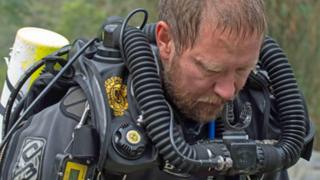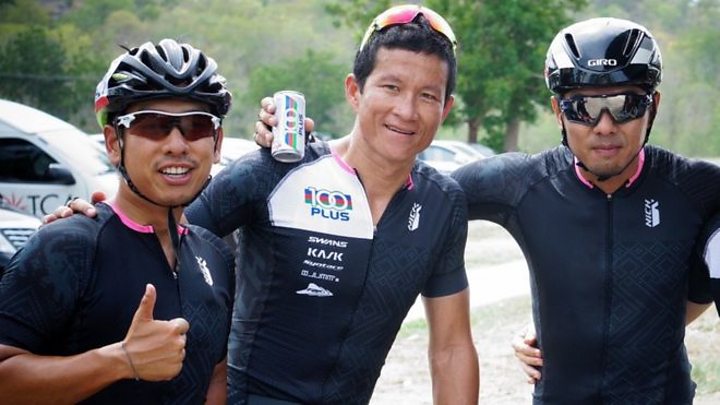
Image copyright
OZTEK/RICHARD HARRIS
Dr Richard Harris spent three days underground with the young Thais and their coach
It was his rare combination of talents that led Australian doctor Richard Harris deep into the Tham Luang cave in Thailand.
When the Wild Boars football team was located deep inside the cave, after being missing for a week, the Adelaide anaesthetist abandoned his holiday in Thailand and volunteered to help.
He went in to assess the boys’ health and stayed with them for three days.
It was under his direction that the weakest boys were first led out with the others successfully following in the complex operation.
Dr Harris, known as Harry, is believed to have been one of the last rescuers out of the cave.
- The heroes who saved the Wild Boars’
- How the operation unfolded
- The rescue in pictures
- Seventeen days in darkness
But relief and celebration were suddenly cut short by personal tragedy – on Wednesday it emerged that Dr Harris’s father had died shortly after the rescue’s finish.
Image copyright
RICHARD HARRIS/FACEBOOK
The Adelaide doctor is globally renowned for his cave-diving expertise
His employer, South Australia’s ambulance service, said his family’s grief had been “magnified” by the physical and emotional demands of the rescue operation.
“It has been a tumultuous week with highs and lows,” Dr Andrew Pearce from MedSTAR said, asking for privacy.
“Harry is a quiet and kind man who did not think twice about offering his support on this mission.”
‘Integral part of the rescue’
Dr Harris was specifically identified by British divers and requested by the “highest levels” of the Thai government to join the rescue, according to the Australian government.
Image copyright
Getty Images
Divers stayed with the boys after they were found deep inside the cave
“He was an integral part of the rescue attempt,” said Foreign Affairs Minister Julie Bishop who added that the doctor was internationally renowned for his cave rescue expertise.
“[The Australians] have been a big help, especially the doctor,” the leader of the rescue mission, acting Chiang Rai governor Narongsak Osotanakorn told an Australian Nine News reporter on Wednesday.
“Very good. The very best,” he said in reference to Dr Harris.

His friend Sue Crowe told the BBC the doctor was an unassuming and selfless family man, whose calm presence would have comforted the boys in the cave.
“He is brilliant with children, and he would have made sure that they were prepared in the best possible way from a cave-diving perspective,” she said.
“He would have been the perfect person to support them.”
On social media, there has been an outpouring of gratitude directed towards him.
Many have called for him to be made Australian of the Year – the nation’s highest civic honour – while the government has indicated there will be some formal recognition.
The experienced diver, also an underwater photographer, has completed several cave-diving expeditions in Australia, New Zealand, Christmas Island and China.
One tragic expedition in 2011, involved the retrieval of the body of his friend, Agnes Milowka, who ran out of air during a cave dive in South Australia.
Image copyright
OZTEK/RICHARD HARRIS
Dr Harris had previously led cave rescue operations
Ms Bishop said the doctor is also known to authorities for his work on medical assistance teams in natural disasters in the Pacific region, and has taken part in Australian aid missions in Vanuatu.
“[He] is an extraordinary Australian and he has certainly made a big difference to the rescue effort here in Thailand,” she said.
She also praised his diving partner, Craig Challen, a vet from Perth who accompanied Dr Harris into the caves.
The pair were part of a team of 20 Australians, including police and navy divers, who assisted in the operation.



